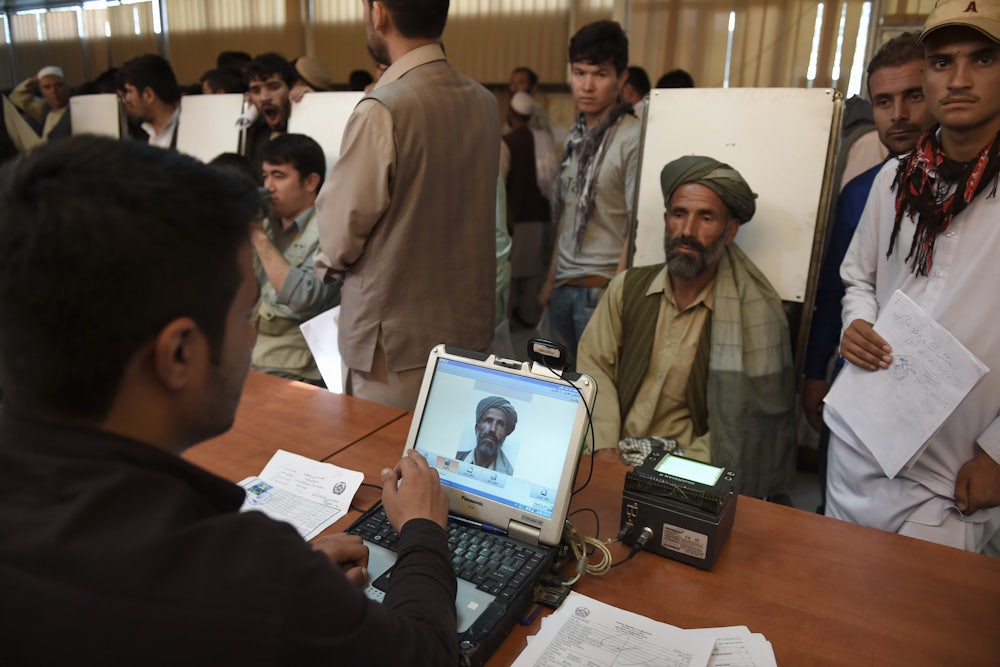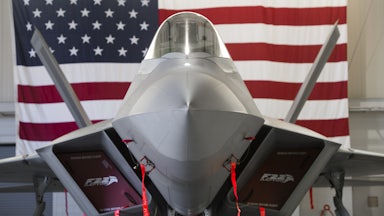Attack helicopters, rifles, drones, vehicles, night vision goggles, uniforms—the list of military gear and materiel left behind by U.S. forces is, well, enough to outfit an army. The physical footprint of the American occupation was enormous; it also includes huge amounts of trash. Officials and commentators are rightly worried about the military equipment now making its way into Taliban hands, but this has been an area of concern for months, ever since the U.S. ghosted on its Afghan government allies at Bagram Airfield in July, leaving behind fleets of abandoned vehicles in a sudden departure. Recent photos of Taliban fighters, especially those guarding leading Taliban officials, show them well-kitted out, with some even wearing the same kind of “tactical” ball caps favored by American special operations forces. From assault rifles to body armor, elite Taliban fighters now look almost identical to their American counterparts.
As the harried U.S. withdrawal continues ahead of the August 31 deadline, other complications are coming into view. The massive surveillance apparatus that the U.S. and its allies set up in Afghanistan—featuring everything from biometric identification to databases of personal information to active monitoring of cell networks—is now finding its way into the hands of the Taliban. There are increasing fears that the technology could be used to help enforce the Taliban’s autocratic rule, or hunt down Afghans who assisted the U.S. or former government officials.
While concerns over how the Taliban may use U.S. surveillance technology are valid, the window for possible action may already be closed. This snafu recalls what should be a constant refrain surrounding our 20-year Afghanistan War: We should never have been there. The vast surveillance operation that the Taliban can now take advantage of is both a symbol of the fear of future Taliban rule and an indictment of America’s own governance in Afghanistan. It affirms that the U.S. and its allies were able to hold the country, however tenuously, only through a violent campaign of kleptocratic warlordism supported by U.S. technology, surveillance, and air power.
It is also a reminder that surveillance technology—especially that which has been a mainstay on the battlefields of the global war on terrorism—remains one of America’s growing export industries. Like the unexploded munitions strewn across the Afghan landscape, the legacy of America’s abandoned data collection and surveillance apparatus will take years to sort out, and may cause the occasional unexpected explosion along the way.
From government databases to telecom call records to taxes to voter registration files, there is a range of resources that a more technologically adept Taliban might make use of. According to Politico, “The rapid takeover of Kabul left large stores of data open for exploitation inside Afghan businesses and government offices.” The new Taliban minister in charge of telecommunications, for example, could order phone companies to produce lists of everyone who ever called an American diplomatic facility. Geolocation data could be used to see who visited someone’s house or who stepped foot on a NATO military base.
There are other areas where concern over what the Taliban might do tips over into horror at what the U.S. and its allies have already done. “The former Afghan government started collecting biometric data about Afghan citizens, including military personnel, in 2006,” reported Politico, noting that the biometric databases include information about ethnicity—a potential problem under a fundamentalist Islamist regime that persecutes minorities. Politico added that “the U.S. government helped the country set up the ability to wiretap and monitor phone calls for surveillance purposes”—without clarifying that this surveillance apparatus served a government defined by corruption, self-dealing, and the running of death squads.
There have been some late-in-the-day efforts to destroy equipment and scrub data. U.S. government websites removed videos and signs of Afghan-American collaboration. Agencies ranging from USAID to the Department of Agriculture are weighing how they might have exposed sensitive information on Afghans. Social media companies have joined the fight, offering tools to let Afghan users, and people with friends in Afghanistan, further lock down their accounts. Ordinary Afghans are purging their phones of forbidden music and otherwise trying to obfuscate their digital identities.
In many respects, it’s too late. According to reports, Taliban fighters are already using handheld American-provisioned biometric scanners at checkpoints and in house-to-house searches. For every surveillance system destroyed or database deleted, others will remain, some perhaps for sale in the secondary market or used as negotiating tools to gain favor with the new regime. Personal data in Afghanistan has been weaponized ever since the initial invasion, when the U.S. solicited names of Al Qaeda fighters for its rendition flights to Guantanamo Bay, leading to the imprisonment of numerous innocents who were reported by aggrieved neighbors or other enemies. Since then, persistent aerial surveillance, cell phone location data, and so-called patterns of life have been at the algorithmic heart of the drone war program that has produced so many casualties.
“Over the last 20 years, Afghanistan became a technological training ground,” wrote Albert Fox Cahn in The Daily Beast. The latest turn in the war’s chaotic aftermath “should be a reckoning for everyone who sold biometric surveillance as a tool for good.”
The scale of the project, even spread out over two decades, is stunning. According to The Intercept, “The Pentagon had a goal to gather biometric data on 80 percent of the Afghan population.” As usual in justifying these kinds of boundless authorities, the given reasoning was to “locate terrorists and criminals.” The Pentagon likely didn’t succeed in that ambition, but another digital ID system, run by Afghanistan’s National Statistics and Information Authority, reportedly processed more than six million applications. The United Nations used its own biometric systems to track more than 1.5 million Afghan refugees.
In seeking to corral most of the population into a biometric database, the U.S. government was doing nothing less than building a system of mass surveillance for an unreliable client state with a rickety (at best) criminal justice system. And it often did so at gunpoint: U.S. troops routinely stormed into villages on night raids, killed or arrested some suspects, and gathered biometric data from everyone (including the dead). This, along with data gathered for routine job applications or for visas, was how the gargantuan surveillance regime was assembled.
Afghans have a right to be worried. The Taliban seems to be assembling the pieces, many of them there for the taking, for a brutally invasive surveillance state, one that could endure. Unlike a password, biometric identifiers cannot be changed; your iris and your fingerprint are permanent. And promises that names have been scrubbed from websites or computer systems are not very reassuring, not in the age of internet archives and tools to forensically reconstruct deleted data. It’s as if the U.S. has seeded the country with digital landmines that might go off at any time. All it takes is a vengeful Taliban official investigating his rival, or a driver being stopped at a checkpoint for an iris scan that turns up some incriminating information.
The perverse truth is that, as with the overall U.S. occupation of Afghanistan, building a system of mass biometric surveillance was considered a good thing—as long as we controlled it. Only when the enterprise began to slip out of friendly hands did someone in power seem to utter an impotent “Oops, we didn’t know.”
But we did know. Or at least, some people did—experts and scholars who constantly beat the drum about the unchecked spread of U.S. surveillance technologies; journalists who investigated Afghan government abuses; and the many activists who warned, two decades ago, that the initial decision to invade Afghanistan was a mistake. In the coming years, as the Taliban ferrets out collaborators using the equipment and databases our own forces left for them, there should be many opportunities for contrition. But any U.S. apologies are cold comfort when there’s a firm knock at the door in the middle of the night.








